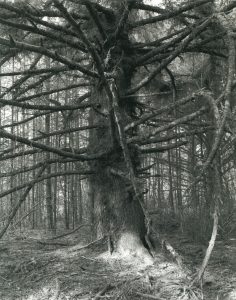
![]() Acclaimed photographer Robert Adams’ extended visual essay about the plight of forests in the Northwest, Turning Back, A Photographic Journal of Re-exploration, includes several images of ancient Sitka spruce trees. The largest spruce in the world, these trees may live for seven to eight hundred years and reach heights of two hundred feet or more. Confined to a narrow range from Alaska to northern California, Sitka spruce may be found from the seashore to elevations as high as three thousand feet. Prized for its very remarkable strength, due to its long, straight grain, the wood is used as spars in boat building and for the manufacture of small airplanes.
Acclaimed photographer Robert Adams’ extended visual essay about the plight of forests in the Northwest, Turning Back, A Photographic Journal of Re-exploration, includes several images of ancient Sitka spruce trees. The largest spruce in the world, these trees may live for seven to eight hundred years and reach heights of two hundred feet or more. Confined to a narrow range from Alaska to northern California, Sitka spruce may be found from the seashore to elevations as high as three thousand feet. Prized for its very remarkable strength, due to its long, straight grain, the wood is used as spars in boat building and for the manufacture of small airplanes.
Adams is not interested in these uses of Sitka spruce lumber; for him, the appeal of these venerable trees rests in their link to the past, especially to an era before wide-scale timber harvesting. As Adams writes in Turning Back, “When the pioneers who settled in this forest went to town for supplies they spoke of going ‘outside.’ It is still possible to sense, in a few parks, a little of what it might have been like to live in the ancient woods, to be inside.”[footnote]Robert Adams, Turning Back: A Photographic Journal of Re-exploration (New York: Frankel Gallery and Matthew Marks Gallery, 2005), p. 24.[/footnote] This is the “back” to which Adams would have us turn – the values inherent in the original forest, still and undisturbed.
Adams notes that the dual themes of Turning Back are “the glory of the natural world and the tragic nature of human beings,” asking “What have we traded for this great forest?” The answer is present in the photographs of clear-cut forests and barren landscapes that comprise the majority of photographs in the series, envisioning what Adams has called an exhaustion of spirit. But this bleak message is countered by photographs of majestic trees, the Sitka spruce and Lombardy poplars that stand as encouragement to look beyond monetary profit to find spiritual reconciliation.
In 2006, Daniel Houghton filmed an interview with Robert Adams on the occasion of the exhibition, Turning Back, at the Middlebury College Museum of Art. Below is an excerpt from that film.